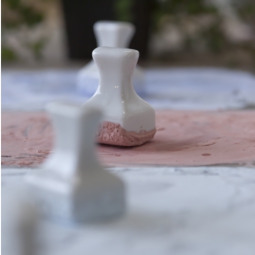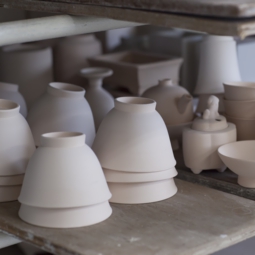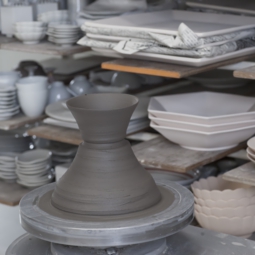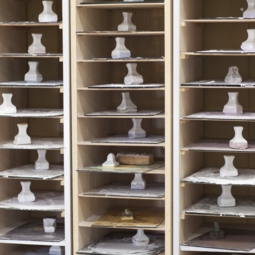九谷毛筆細字について
「九谷毛筆細字(さいじ)技法」とは、主に和歌などの古典文学を極細の毛筆で磁器に描き込む技法です。明治以降、九谷焼の繊細な絵付けに見合う表現として石川県の南部地方で独自に発展してきました。
現在まで一世紀以上に亘り、田村家に一子相伝の技法として受け継がれています。
細字はマンガンを原料とした釉薬で描かれた後、約800度で焼成されます。粘性のある釉薬を用いて極小の文字を描くことは難しく、技術の修得には長い年月を要します。
立体で曲面の多い素磁に絵付け全体とのバランスを図りながら、細字を描く作業は裸眼で行います。また、器の内側に描く際は、縦の線は下から上に引くなど通常とは異なる書き順を用います。
独自のさまざまな工夫を凝らしながら、極小でありがながらも書としての美を兼ね備えた文字表現を目指しています。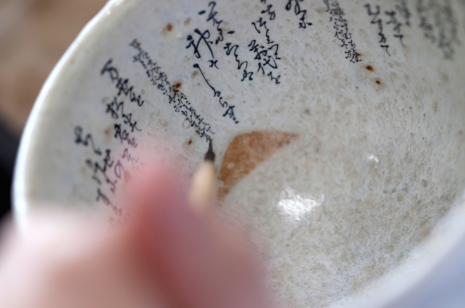
SAIJI – The Amazing Art of Brush-writing
Micro Calligraphy on Kutani Ware
The art of brush-writing micro calligraphy on ceramic ware has been developed as a feature unique to Kutani ware—Japanese traditional porcelain known for its refined, colorful designs. This art, which requires great skill and intense practice, has been passed down over a century from its founder, Seizan Oda, to his descendants, Kinsei Tamura and Keisei Tamura.
It was in the early Meiji period (late 19th century) in the village of Kutani that the brush-writing of Chinese classical poems inside tea cups and sake cups began, influenced by skillful painters and their sophisticated paintings of that time.
After years of devoted efforts and hard work, Seizan Oda began writing inside tea cups in 1894 and developed the art of brush-writing micro calligraphy on his own. By 1900, he also began writing Japanese classical poem in Japanese characters, and brought this art to perfection. He polished his unparalleled skill even further in the early 20th century, to the extent of writing all the 100 Hyakunin-Isshu poems inside a Western cup of a mere 3 cm in diameter, and also 500 waka poems by Emperor Meiji inside a Japanese tea cup. These miraculous achievements of micro calligraphy earned him the reputation of having the “hands of a god”.
This art was then inherited by Kinsei Tamura, the husband of Seizan’s daughter, whose artistic talent became rapidly apparent. With his inherent calligraphic skill and inventor’s spirit, he was the first to combine micro calligraphy with traditional Kutani paintings. Before Kinsei, characters had never been given equal importance with paintings applied on Kutani ware—they had been written only in the blank space inside.
Kinsei created well-balanced, sophisticated works of art in succession, and captured the highest position in this genre of art.
The art of brush-writing micro calligraphy has been handed down through four generations over one century, from a father to only one of his offspring. With hard work and dedication, it is practiced today by Keisei Tamura, the grandson of Kinsei, along with Seito , daughter of Keisei. Both Keisei and Seito are committed to further enhancing their skills to portray the elegance of the world of Japanese classical literature in a contemporary manner.


